 |
| April 25, 2017 | Volume 13 Issue 16 |
Designfax weekly eMagazine
Archives
Partners
Manufacturing Center
Product Spotlight
Modern Applications News
Metalworking Ideas For
Today's Job Shops
Tooling and Production
Strategies for large
metalworking plants
Wings:
Siemens electric airplane motor setting records left and right, up and down
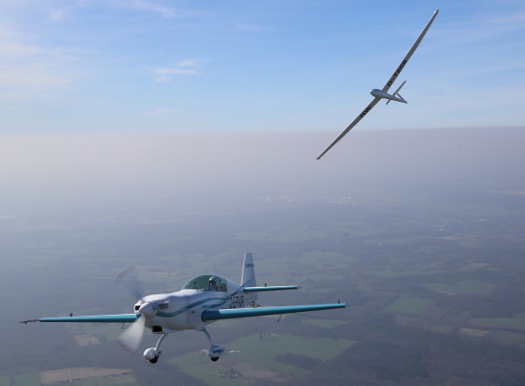
Among other recent firsts, the Extra 330LE aerobatic plane -- powered by a Siemens electric propulsion system -- became the first electric aircraft to tow a glider into the sky. [This image copyright: Jean-Marie Urlacher. All images courtesy: Siemens]
Electric motor technologies in aircraft are making steady development progress -- and setting records along the way.
Case in point is the Extra 330LE aerobatic plane, powered by a propulsion system from Siemens, which set several records recently.
On March 23, 2017, the Extra 330LE grabbed two new speed records. At the Dinslaken Schwarze Heide airfield in Germany, the electric aircraft reached a top speed of 337.50 kilometers per hour (km/h) over a distance of 3 km. The speed achieved by pilot Walter Extra was 13.48 km/h faster than the previous record, which had been set by U.S. pilot William M. Yates in 2013. The World Air Sports Federation (FAI) officially recognized the record flight in the category "Electric airplanes with a take-off weight less than 1,000 kilograms."
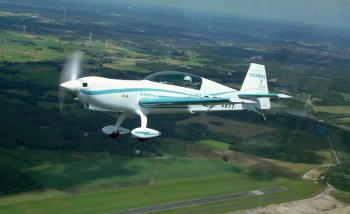
For the first time ever, a plane in the certification category CS23 flies with Permit-to-Fly purely electric. The plane is powered by a 260-kW Siemens motor that weighs a mere 50 kg -- a record-setting power-to-weight ratio.
The Extra plane also set a new FAI world record in the category "above 1,000 kilograms." In a slightly modified configuration with an overall weight exceeding 1 metric ton, test pilot Walter Kampsmann flew the electrically powered plane at a speed of 342.86 km/h.
And on March 24, 2017, the Extra 330LE gave another premiere performance by becoming the world's first electric aircraft to tow a glider into the sky. The nearly silent aerotow piloted by Walter Extra took a type LS8-neo glider up to a height of 600 m in only 76 sec.
"This aerotow provides further highly visible evidence of our record-setting motor's performance capabilities," said Frank Anton, head of eAircraft at the Siemens venture capital unit called next47. "Just six such propulsion units would be sufficient to power a typical 19-seat hybrid-electric airplane."
The new propulsion system from Siemens only recently completed its maiden flight in July 2016. In addition, the lightweight electric motor for aircraft already held a world record for power-to-weight ratio: Weighing just 50 kg (110 lb), it supplies a constant electric output of 260 kW, which is five times more than comparable propulsion systems.
The motor has been specially designed for use in hybrid aircraft where the electric motors are used for high energy-demand tasks like takeoff and climbing.
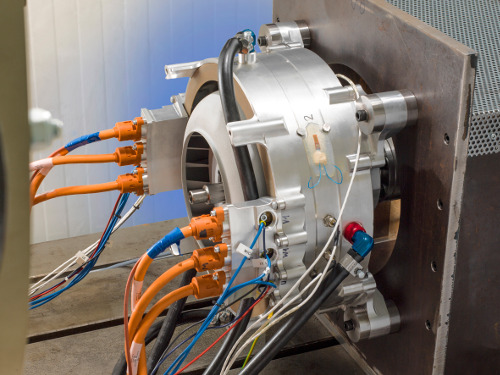
The motor, specially designed for use in aircraft, is shown here being tested on a test rig.
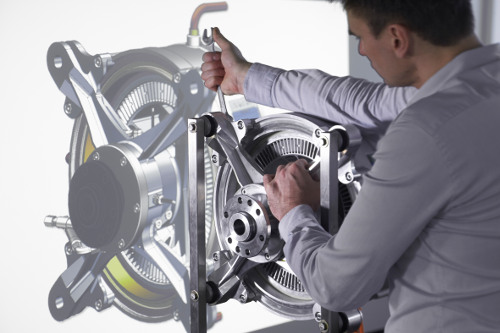
To implement the world-record motor, Siemens' experts scrutinized all the components of previous motors and optimized them up to their technical limits.
The Extra 330LE, which in its normal configuration weighs about 1,000 kg, serves as the flying test bed for the new propulsion system. As an aerobatic plane, it is particularly well suited for taking the components to their stress limits and for testing and enhancing them. Currently, there are no plans for series production of this electric plane.
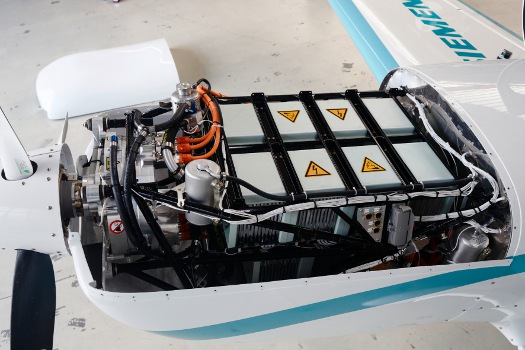
Thanks to its tube-cage construction, the Extra 330LE's key components, such as the motor, inverter, and batteries, can be easily and flexibly installed.
Siemens is also developing this technology in a joint project with Airbus in the area of electrically powered flight. The two companies signed a collaboration agreement in April 2016. Electric propulsion systems are scalable, and Siemens and Airbus intend to develop hybrid-electric regional aircraft on the basis of this record-setting motor.
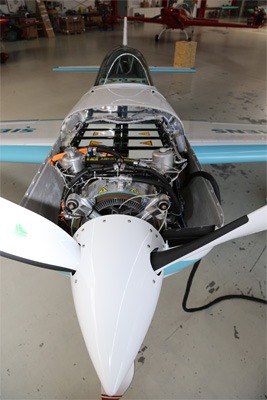
At the Dinslaken Schwarze Heide airfield in Germany, the Extra 330LE aerobatic plane, powered by the new Siemens electric motor, reached a top speed of 340 kph -- a new world record.
"By 2030, we expect to see the first planes carrying up to 100 passengers and having a range of about 1,000 kilometers," said Anton. Siemens is determined to establish hybrid-electric propulsion systems for aircraft as a future area of business.
Larger aircraft with takeoff weights of up to 2 tons will be able to use electric drives for the first time.
To design and build the world-record motor, Siemens' experts scrutinized all the components of previous motors and optimized them up to their technical limits. New simulation techniques and sophisticated lightweight construction enabled the drive system to achieve its unique weight-to-performance ratio of 5 kW/kg. The electric motors of comparable strength that are used in industrial applications deliver less than 1 kW/kg. The performance of the drive systems used in electric vehicles is about 2 kW/kg. Since the new motor delivers its record-setting performance at rotational speeds of just 2,500 rpm, it can drive propellers directly, without the use of a transmission.
But the development process is all baby steps -- although this is a big baby moving fast.
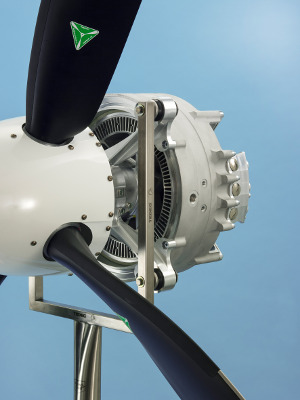
Siemens has developed an exceptional electric motor that combines high power with minimal weight, resulting in a drive system that sets a world record for power/weight ratio in its class. It's a major step toward the everyday use of electrically powered, hybrid aircraft and helicopters.
Airbus Group and Siemens plan to jointly develop prototypes for various propulsion systems with power classes ranging from a few 100 kW up to 10 MW and more for short, local trips with aircraft below 100 seats, helicopters, or UAVs.
Both companies together with Austria's Diamond Aircraft initially presented a hybrid aircraft back in 2011. Since then, Siemens has been developing its electric engine for aircraft that supplies five times as much power while retaining the same weight.
In 2013, Siemens, Airbus, and Diamond Aircraft successfully flight-tested a series hybrid-electric drive in a DA36 E-Star 2 motor glider for the first time. The test aircraft had a power output of 60 kW.
Airbus Group has been gathering operational experience with electrically powered aircraft since 2014 with the E-Fan, a full electric two-seater dedicated to training pilots. Its success has been achieved together with various industrial partners and steadfast support of the French government.
Hybrid-electric propulsion systems can significantly reduce fuel consumption of aircraft and reduce noise. European emissions targets aim for a 75 percent reduction of CO2 emissions by 2050 compared to the values for the year 2000. These ambitious goals cannot be achieved by conventional technologies.
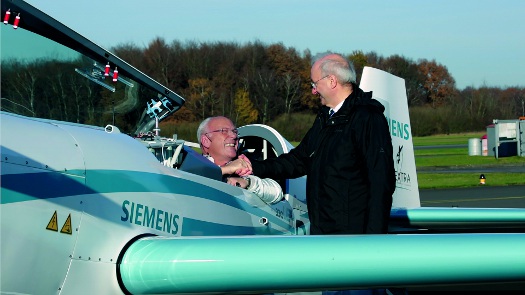
Frank Anton (right), who heads eAircraft within the next47 startup unit, congratulates pilot Walter Extra, who also broke the world record for fastest ascent on Nov. 25, 2016. The electric aircraft reached an altitude of 3,000 m in only 4 min. 22 sec. The airplane rose into the air at 11.5 m/sec.
Source: Siemens
Published April 2017
Rate this article
View our terms of use and privacy policy
